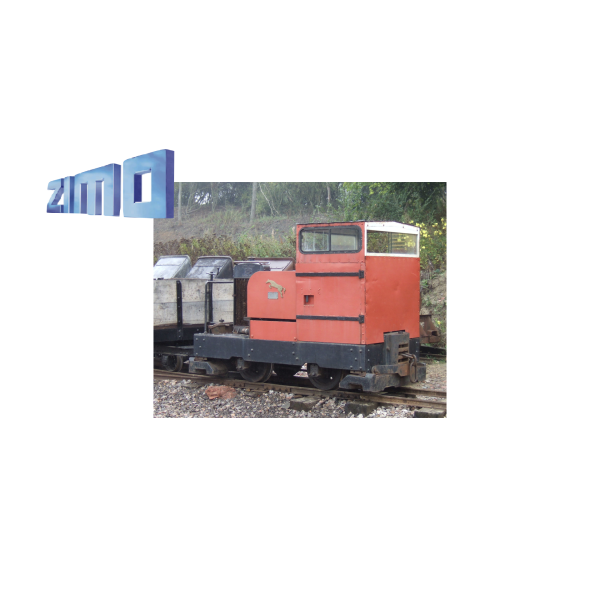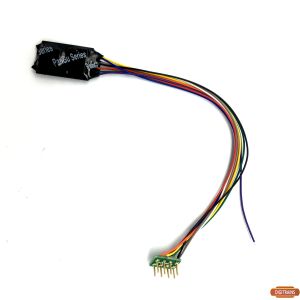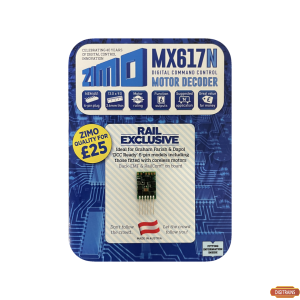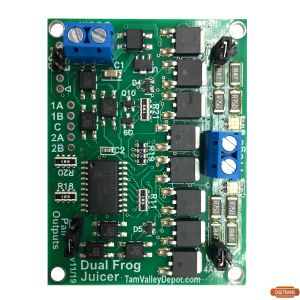ZSSA Motor Rail Simplex Petrol or Diesel DigiDrive project for ZIMO decoders V17.07
Please spend a few moments to read these notes which have been produced so that you may obtain the maximum satisfaction from your new sound scheme.
The sounds should work perfectly when the decoder is fitted correctly. Individual locos may require some fine tuning that you can achieve with your DCC controller.
The sounds have been programmed in such a way that you, the user, may change the way that the sounds respond to your driving style or needs. This avoids the need for reprogramming and all the additional costs that would imply.
Throttle Response Scheme.
As supplied, the decoder will produce the sounds of a Petrol Engine Simplex with a train on the hook.
After the start-up routine the loco will stand with the diesel engine ticking over at idle.
The sounds will respond to the throttle control in the following way:
Select speed step 1. The engine will increase power to get the loco moving, and will continue at high power. The sounds will spool down to idle on deceleration.
The model can be driven in this way without ever needing to use any control other than the throttle.
You will hear gearbox whine which varies in pitch with actual road speed, not engine speed, to give an indication of acceleration/deceleration.
For something more immersive there are extra control features to further enhance your driving pleasure.
Heavy Train/Light Engine Mode Selection
The default setting is for ‘heavy train’. Inertia is high so acceleration (and deceleration) is restricted.
Activated by F5, Light Engine enables multi-function changes with one key. The switched features include reduced inertia setting to allow more rapid acceleration and engine sounds which are quieter
F5 can be operated at any speed to give another way in which the engine sounds at a given road speed may be modified instantly.
Note. This works best if you switch F5 on or off whilst the engine sounds are playing in idle. Once switched, you can leave it that way, but any further change should also be made with the engine sound again playing the idle loop. Just to be clear, the actual speed is unimportant, but the engine sound must be idling. You can achieve this in several ways as discussed above.
Gear Changing
From my observations there seems little use of gear changing. Selecting an appropriate gear for the load and gradient before starting is quite common now, so I assume this has always been the case.
They are in any case low speed machines.
It’s possible, however, to simulate gear changes quite easily as follows.;
When the engine achieves a steady power sound, reduce the speed steps by 1 (or more) and the engine will spool down to idle. Petrol and Diesel react at different rates to this command.
Any subsequent increase in speed steps (1 or more) will cause the engine to rev up again.
To aid this ssimulation, there is the sound of crunching gears on F6 which can be used just prior to increasing speed steps to indicate a gear change.
Of course, if you are the master of the Cone clutch you may not wish to abuse your gears in this way, that’s why it’s an optional sound. Maybe occasional use will bring a touch of authenticity.
Brakes
The real locos rely on engine braking and a wheel-applied hand brake to slow down or stop. I have not, therefore, fitted a separate braking function in this project, so you may need to adjust CV4 to suit.
The sound of the applied handbrake will sound automatically just prior to the loco finally stopping. This can be adjusted within the project if required.
Tip: F5 temporarily reduces the value in CV4 to simulate Light Engine levels of momentum. Using F5 when in Heavy mode will shorten stopping distances.
Audible Warning Devices
There does not appear to be a standard AWD so I have included several types I found fitted to Simplex or Motor Rail locomotives.
The exhaust manifold whistle is interesting as its tone and duration varies with engine speed. At low speed, there are low frequency whistles which are quite loud, whilst at high speeds this changes to higher frequency, shorter duration ‘toots’.
F2 and F4 have whistle sounds to be used when engine is slow or idling whilst that on F3 has the sounds for use with full power. This is a repeating function and will continue until you cancel the key.
A manually operated ‘quack’ sound, recorded from an armoured Simplex, is in the decoder memory but not assigned to any F key. (Its sound ID is 22, so it can be assigned if required.
Mute
F key 19 provides a ‘Fade to Mute’ function. When engaged, all sounds will fade to silence; when disengaged sound will return to previous volume setting by fading in.
Live Volume Control
Provided the sound is switched on and the ‘fade’ button is not active, it is possible to change the overall volume to suit changing needs.
Engage F17 and the sound levels will gradually reduce, eventually to silence
Engage F18 and the sound levels will gradually increase, eventually to maximum.
In each case, disengage the F key when the desired level is attained. Set F17 and F18 as ‘momentary’ if your DCC controller allows you to do so.
Note: If the volume controls appear to not function, check that F17, F18 and F19 are disengaged before making a further attempt.
Petrol and Diesel Sound Sets
This ‘DualFuel’ version provides the different engine sounds to simulate either a Petrol or Diesel Engine. These use genuine recordings from Simplex locomotives.
All the above notes apply equally to either engine type so there should be little problem in adapting to each of them as required.
To change engine type requires rather less effort than real-life engine conversions. The default engine is the earlier standard petrol type.
This is selected with CV265 = 101
For the diesel engine, CV265 = 103
It’s now down to your skill and knowledge to simulate any eventuality!
Function List
|
F Key
|
Function/Sound
|
Latch/
Momentary
|
Sound
CV
|
Volume
CV
|
Loop
CV
|
Sound
ID(s)
|
|
0
|
Lights (if fitted)
|
L
|
570
|
571
|
572
|
-
|
|
1
|
Sound On/Off
|
L
|
513
|
514
|
515
|
-
|
|
2
|
Manifold Whistle Slow
|
M
|
516
|
517
|
518
|
24 (22)
|
|
3
|
Manifold Whistle Fast
|
M
|
519
|
520
|
521
|
25 (22)
|
|
4
|
Manifold Whistle Slow
|
M
|
522
|
523
|
524
|
26 (22)
|
|
5
|
Light Engine Mode
|
L
|
525
|
526
|
527
|
-
|
|
6
|
Crunching Gears
|
M
|
528
|
529
|
530
|
20
|
|
7
|
Klaxon (Variable duration)
|
M
|
531
|
532
|
533
|
30 (22)
|
|
8
|
Klaxon Short
|
M
|
534
|
535
|
536
|
31 (22)
|
|
9
|
Flange Squeal
|
L
|
537
|
538
|
539
|
27
|
|
10
|
Wagon Coupling
|
M
|
540
|
541
|
542
|
29
|
|
11
|
Despatch Whistle
|
M
|
543
|
544
|
545
|
28
|
|
12
|
Stream Sounds
|
L
|
546
|
547
|
548
|
19
|
|
13
|
Blair Atholl Mill
|
L
|
549
|
550
|
551
|
33
|
|
14
|
Wild Birds
|
L
|
552
|
553
|
554
|
35
|
|
15
|
Single shotgun (Exhaust back-fire?)
|
M
|
555
|
556
|
557
|
36
|
|
16
|
Double shotgun
|
M
|
558
|
559
|
560
|
34
|
|
17
|
Volume Down
|
M
|
561
|
562
|
563
|
|
|
18
|
Volume up
|
M
|
564
|
565
|
566
|
|
|
19
|
Fade All Sounds
|
M
|
567
|
568
|
569
|
|
|
20
|
Reserved
|
-
|
673
|
674
|
675
|
(22)
|
|
21
|
Reserved
|
-
|
676
|
676
|
678
|
(22)
|
|
22
|
Reserved
|
-
|
679
|
680
|
681
|
(22)
|
|
23
|
Reserved
|
-
|
682
|
683
|
684
|
(22)
|
|
24
|
Reserved
|
-
|
685
|
686
|
687
|
(22)
|
|
25
|
Reserved
|
-
|
688
|
689
|
690
|
(22)
|
|
26
|
Reserved
|
-
|
691
|
692
|
693
|
(22)
|
|
27
|
Reserved
|
-
|
694
|
695
|
696
|
(22)
|
|
28
|
Reserved
|
-
|
697
|
698
|
699
|
(22)
|
The table shows the project defaults; you can always return to these by programming CV8 = 8.
The Momentary/Latching column shows my recommendation if your DCC system allows you to assign this choice to that F key.
The Sound CV Column shows the CVs which contain the sound for the respective F keys.
The Sound ID is the value in the Sound CV used to assign the sound sample. If there are alternative sounds of a similar type they will be shown in parenthesis and the project default will be shown in bold. These values will differ between sound projects, so only those shown applicable here.
The Volume CVs always apply to the F keys shown, whatever sound is actually installed. If there is a sound assigned to these F keys, the volume of that individual sound may be varied, in isolation, by changing the value in the respective CVs shown. Value range is 1 – 255. (0 is equivalent to 255).
As an aid, these are the values equivalent to a range of sound levels:
|
Value
|
Attenuation
|
|
|
1
|
> -27dB
|
Minimum Volume
|
|
11
|
-27dB
|
|
|
16
|
-24dB
|
|
|
23
|
-21dB
|
|
|
32
|
-18dB
|
|
|
46
|
-15dB
|
|
|
64
|
-12dB
|
|
|
91
|
-9dB
|
|
|
128
|
-6dB
|
|
|
181
|
-3dB
|
|
|
0 or 255
|
-0dB
|
Maximum Volume
|
Paul Chetter
Lincoln
July 2017






